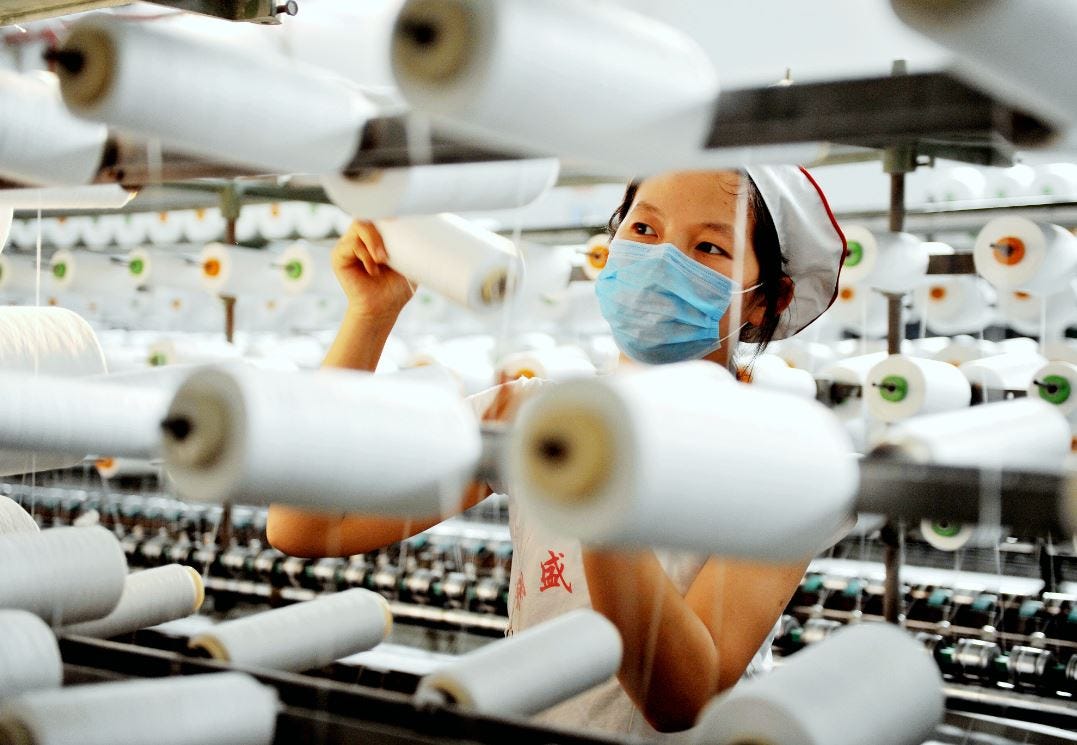Struggling China's Textile Industry: A case study of Texhong Group and the road ahead.
China's textile industry, once a global powerhouse, is facing headwinds. Weakening demand, rising costs, and fierce competition are putting pressure on profit margins and threatening the industry's future. The challenges are many. A look at Texhong International Group, once a textile industry superstar, now grappling with plunging profits and a bleak outlook gives a glimpse of the overall situation. This story serves as a microcosm of the challenges facing China's textile industry as a whole.

Beyond Texhong: China’s challenges
Texhong reported a net loss of 300 million yuan in 2023, reversing a 200 million yuan profit the previous year. Revenue from yarn sales fell 12.4 per cent to 8 billion yuan in the first half of 2023. Gross margin for yarns barely stayed positive at just 0.7 per cent. At the same time, China’s cotton imports fell 17.6 per cent in 2022-23 season.
A look at the domestic market
As China's population ages and economic growth slows, domestic demand for textiles is weakening. Retail sales growth in apparel and textiles has been declining, with 2023 figures showing a drop of 6.2 per cent compared to 2022 as per National Bureau of Statistics of China. Add to it rising competition from online retailers. Traditional brick-and-mortar stores are struggling to compete with online platforms like Alibaba and JD.com, which offer lower prices and wider selections. Also, the Chinese textile industry is heavily concentrated in the low-end segment, facing fierce competition and low profit margins.
Meanwhile, global trade slowdown and ongoing trade war between the US and China, coupled with the global economic slowdown, has dampened demand for Chinese textile exports. The US has imposed additional tariffs on Chinese textiles, making them less competitive in the American market.
Labor costs too are a burden having gone up significantly, with average wages in the textile industry increasing by 8 per cent annually between 2020 and 2022 as per China’s Ministry of Human Resources and Social Security stats. Additionally, raw material costs like cotton have fluctuated, posing challenges for profit margins.
Moreover, Southeast Asian countries like Vietnam and Bangladesh are attracting textile manufacturers with lower labor costs and more favorable trade policies.
Factors affecting industry
|
Challenge |
Impact |
2021 Stat |
2022 Stat |
2023 Stat (projected) |
Source |
|
Declining domestic demand |
Lower sales, reduced profitability |
-3.2% growth |
-5.4% growth |
-6.2% growth |
National Bureau of Statistics of China |
|
Rising online competition |
Market share loss for traditional stores |
45% online sales |
52% online sales |
60% online sales |
China E-commerce Research Center |
|
Global trade slowdown |
Reduced export volume |
$260 billion exports |
$245 billion exports |
$230 billion exports |
World Trade Organization |
|
Rising US tariffs |
Increased production costs, reduced competitiveness |
10% average tariff |
15% average tariff |
20% average tariff (estimated) |
US Trade Representative |
China's textile industry (2020-2022) at a glance
|
Statistic |
2020 |
2021 |
2022 |
|
Textile industry revenue (trillion yuan) |
3.1 |
3.3 |
3.4 |
|
Textile exports (billion $) |
254 |
268 |
252 |
|
Number of textile enterprises (million) |
442 |
438 |
435 |
|
Textile industry employment (million) |
12.7 |
12.5 |
12.3 |
|
Metric |
2021 |
2022 |
2023 (YTD) |
Change (2021-2023) |
|
Textile Exports ($ billion) |
297.5 |
280.1 |
221.3 |
-25.60% |
|
Domestic Textile Sales ($ billion) |
352.2 |
348.9 |
340.5 |
-3.30% |
|
Average Textile Export Price ($/Ton) |
2,223 |
2,098 |
1,975 |
-11.10% |
|
Textile Industry Profit Margin (%) |
6.2 |
4.8 |
3.2 |
-48.40% |
What lies ahead for China
Despite the challenges, the Chinese textile industry still has the potential for growth, but it needs to adapt and transform. Some key trends shaping the future are:
Focus on value-added products: Moving away from low-cost, commoditized products towards technical textiles, functional apparel, and sustainable materials.
Embracing automation and technology: Investing in robotics, artificial intelligence, and other technologies to improve efficiency and productivity.
Building strong brands: Creating domestic brands with unique designs and high quality to compete internationally.
Expanding into new markets: Diversifying export markets beyond the US and Europe to mitigate trade risks.
Focus on sustainability: Implementing sustainable practices throughout the supply chain to meet growing consumer demand and international regulations.
The success of Chinese textile industry in the future will depend on its ability to embrace these changes and adapt to the evolving global market landscape.
